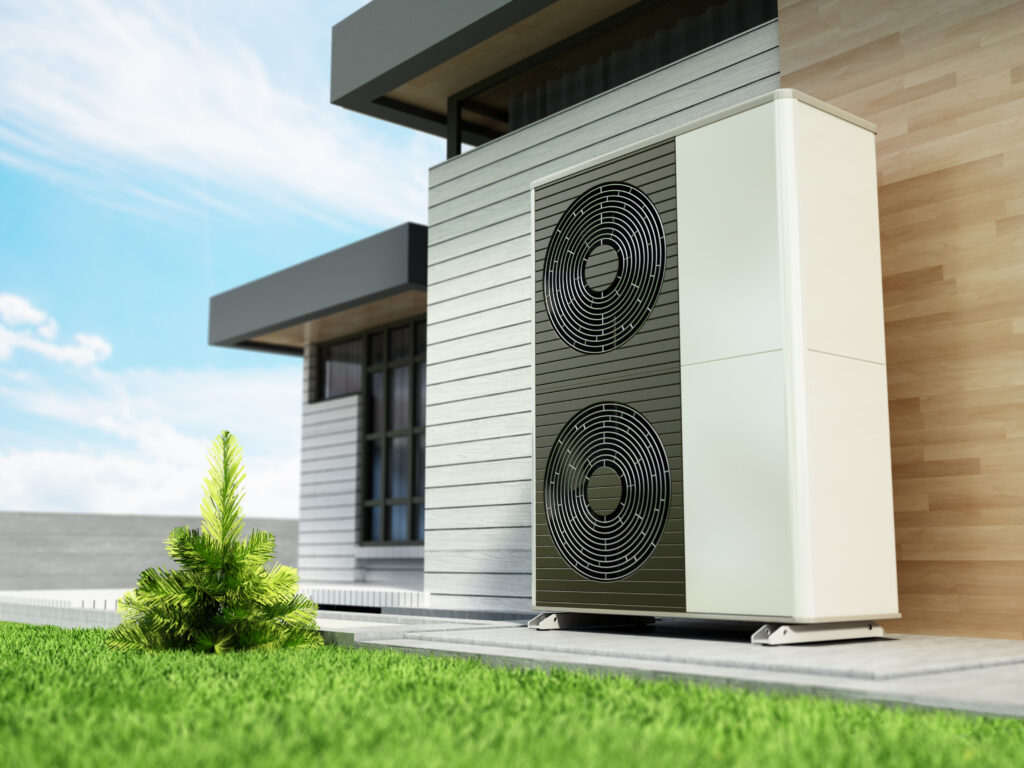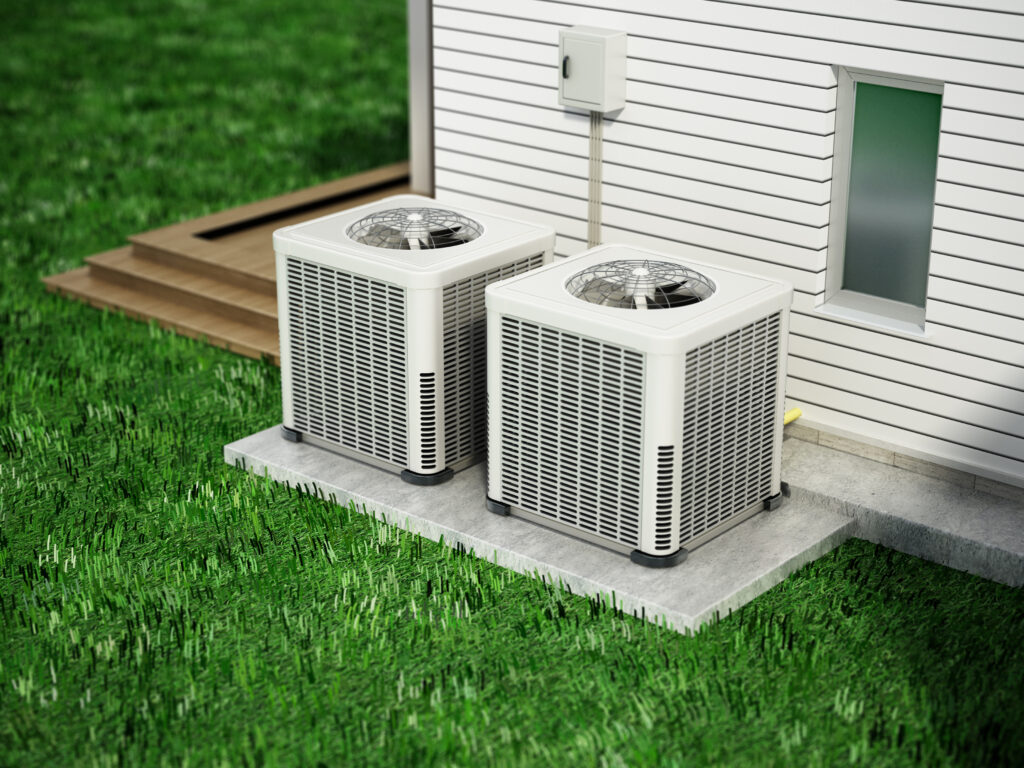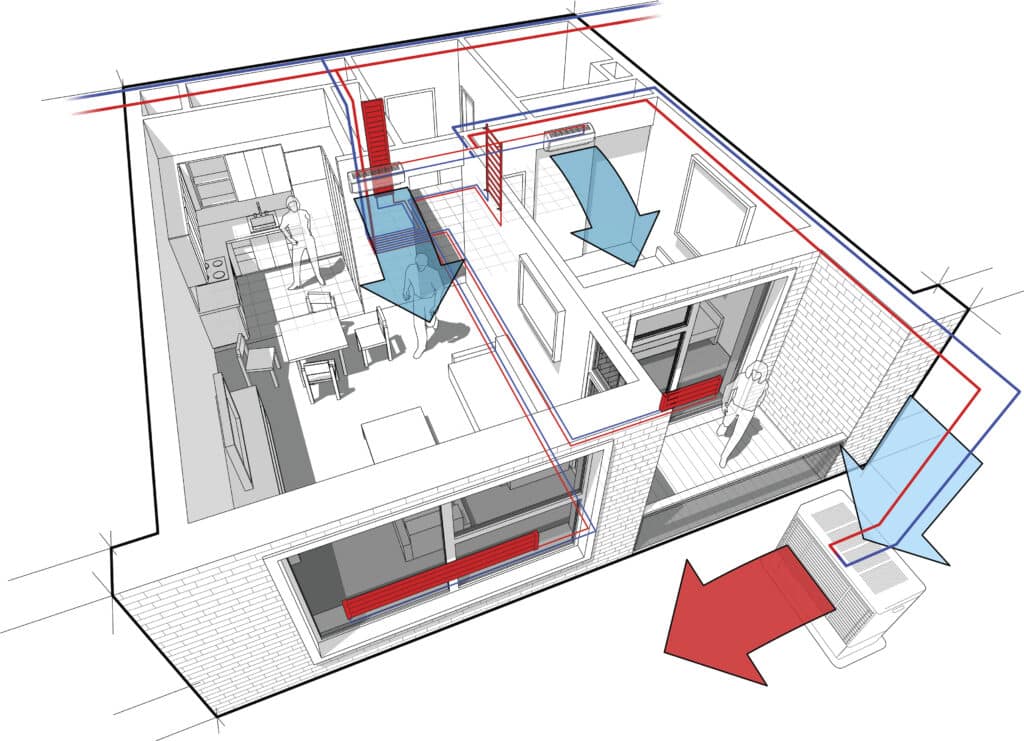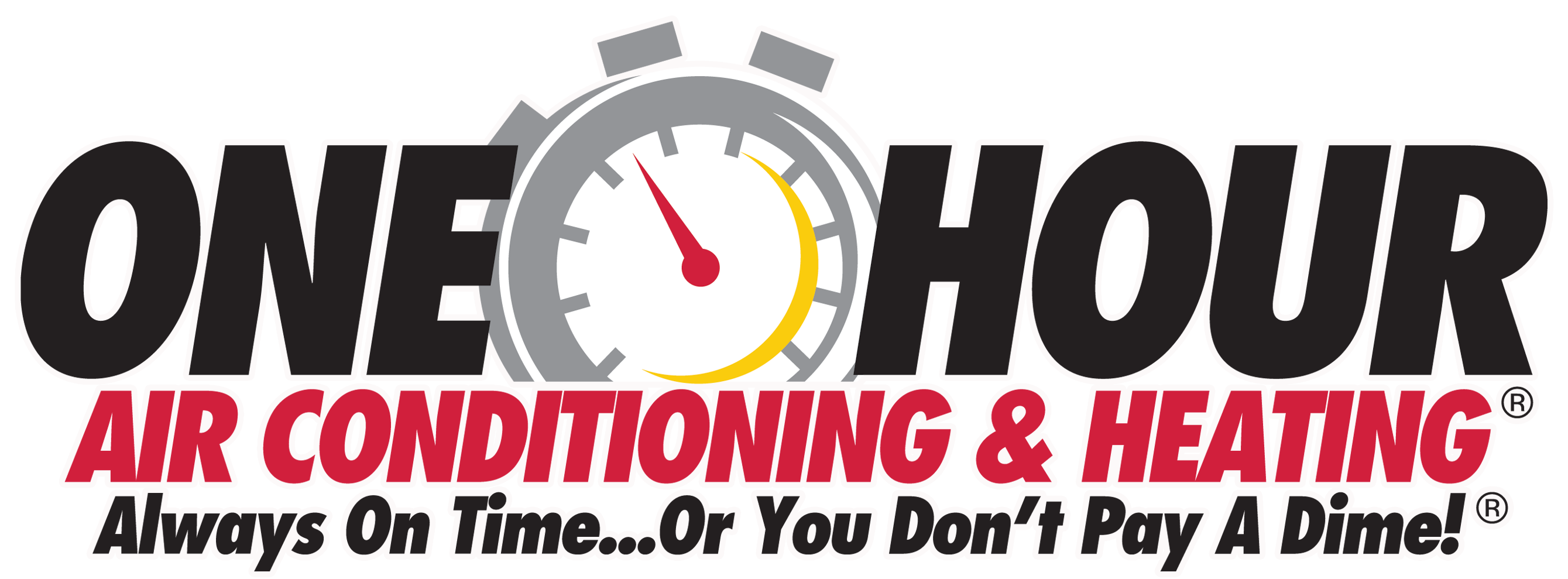
Secrets of Residential HVAC Design: A Comprehensive Guide

Have you ever wondered how the comfort of your home environment is so meticulously maintained, regardless of the weather outside?
Whether it’s the chill of winter or the heat of summer, your home remains a sanctuary of comfort. This is largely thanks to the science and art of residential HVAC design, a crucial aspect of home construction and maintenance that ensures your living space is always welcoming.
In this article, we delve deep into the world of residential HVAC design, exploring its importance, the principles behind it, and how it impacts your daily life.
You’ll gain insights into the latest trends, best practices, and essential tips to ensure your home’s HVAC system is not only effective but also efficient and environmentally friendly.

What is Residential HVAC Design?
Residential HVAC design is the strategic planning and implementation of heating, ventilation, and air conditioning systems within a home to provide optimal thermal comfort and air quality.
This process is a critical component in ensuring that your living space is not only comfortable but also energy-efficient and environmentally friendly.
When we talk about residential HVAC design, we’re referring to a comprehensive approach that considers various factors such as the home’s size, layout, orientation, insulation levels, and even the local climate. The goal is to create a system that not only meets the homeowner’s specific needs but also operates efficiently, conserving energy and reducing costs.
The design process begins with a detailed analysis, often starting with a load calculation. This calculation determines the amount of heating and cooling required to maintain the desired indoor temperature in different areas of the home.
It takes into account various factors, including the number of windows, the type of insulation, and the presence of heat-emitting appliances. This step is crucial because an improperly sized HVAC system can lead to inefficiencies, increased wear and tear, and uncomfortable indoor environments.
Energy efficiency is a cornerstone of modern residential HVAC design. Designers aim to incorporate systems that use less energy, reduce greenhouse gas emissions, and lower homeowners’ utility bills. This might involve choosing high-efficiency units, integrating smart thermostats, or employing renewable energy sources like solar power.
Indoor air quality is another critical aspect of residential HVAC design.
A well-designed system will ensure adequate ventilation and filtration, removing contaminants from the air and preventing mold growth. This is particularly important for individuals with allergies or respiratory issues, as it contributes to a healthier living environment.
Sustainability is also a key consideration in residential HVAC design.
Designers strive to select materials and systems that have a minimal environmental impact, promoting a healthier planet alongside comfortable living spaces.
Residential HVAC design is a multifaceted process that plays a pivotal role in creating livable, comfortable, and sustainable homes.
It’s about much more than just installing equipment; it’s about crafting tailored solutions that enhance the quality of life while respecting our planet.
Understanding the Basics of Residential HVAC Design
Core Objectives
At its core, residential HVAC design is all about creating a system that efficiently regulates indoor temperature and air quality, ensuring that your home is a comfortable sanctuary regardless of the weather outside.
This process is fundamental to achieving a harmonious balance between comfort, efficiency, and health within your living space.
Selecting the Right Equipment
Choosing the right equipment is a cornerstone of effective residential HVAC design. This decision should be based on the specific needs and constraints of your home.
Factors such as the size of your home, the local climate, and your energy efficiency goals all play a crucial role in determining the best HVAC system for your space.
Whether it’s a furnace, heat pump, air conditioner, or a combination of these, selecting the right equipment is crucial for optimizing performance and energy efficiency.
Designing the Layout of Ductwork
The design of the ductwork is another critical aspect of residential HVAC design.
Properly designed ductwork ensures that air is distributed evenly throughout your home, eliminating hot or cold spots and promoting a comfortable environment in every room.
The layout should minimize turns and length to enhance efficiency and reduce energy loss. Moreover, ensuring that ducts are properly sealed and insulated is vital to prevent energy wastage and maintain optimal system performance.
Proper Sizing of the System
Ensuring that the HVAC system is properly sized is perhaps one of the most critical aspects of residential HVAC design.
An oversized system can lead to unnecessary energy consumption and frequent cycling, which can wear down components and reduce the system’s lifespan. Conversely, an undersized system will struggle to maintain the desired indoor temperature, leading to inefficiency and discomfort.
Conducting a detailed load calculation, which considers various factors like insulation, window size, and household occupancy, is essential to determine the appropriate size for your HVAC system.
Understanding the basics of residential HVAC design is crucial for homeowners who wish to enhance their living environment.
By focusing on selecting the right equipment, designing efficient ductwork, and sizing the system correctly, you can ensure that your HVAC system provides optimal comfort, air quality, and energy efficiency. This foundational knowledge empowers homeowners to make informed decisions about their HVAC systems, leading to a more comfortable, healthy, and sustainable home.
The Importance of Proper Sizing in Residential HVAC Design
Critical Role of Accurate Sizing
Proper sizing is a pivotal aspect of residential HVAC design, directly influencing the system’s efficiency, performance, and longevity.
An appropriately sized HVAC system ensures that your home maintains a consistent and comfortable temperature, optimizes energy usage, and extends the lifespan of the system.
Consequences of Oversizing
An oversized HVAC system can lead to several problems, including short cycling, where the system turns on and off more frequently than necessary.
This not only leads to increased wear and tear on the system, reducing its lifespan, but also results in higher energy consumption and costs.
Moreover, an oversized system struggles to effectively remove humidity from the air, which can lead to a feeling of clamminess and discomfort within the home.
Drawbacks of Undersizing
On the other hand, an undersized system will constantly struggle to reach and maintain the desired temperature, particularly during extreme weather conditions. This continuous operation can lead to excessive energy consumption, increased utility bills, and undue strain on the system, potentially leading to more frequent repairs and a shorter system lifespan.
The Role of Load Calculations
Load calculations are the cornerstone of determining the proper size for your HVAC system. This process involves a detailed analysis of various factors, including the home’s square footage, layout, insulation quality, window size and orientation, local climate, and even the number of occupants.
By considering these elements, HVAC professionals can accurately determine the heating and cooling capacity required to maintain comfort and efficiency in your home.
How to Choose the Right HVAC Professional
It’s essential to work with a qualified HVAC professional who can conduct a comprehensive load calculation and recommend the appropriate size for your system. This expertise ensures that your HVAC system is tailored to your home’s specific needs, providing optimal comfort and efficiency while avoiding the pitfalls of incorrect sizing.
Understanding the importance of proper sizing in residential HVAC design is crucial for homeowners.
By ensuring your system is neither oversized nor undersized, you can achieve a balance of comfort, efficiency, and cost-effectiveness, making your home a more pleasant and sustainable environment.
Always rely on professional guidance to make informed decisions about your HVAC system’s size, ensuring it’s perfectly suited to your home’s unique requirements.
Energy Efficiency and Sustainability in Residential HVAC Design
Emphasizing Energy Efficiency
In the realm of modern residential HVAC design, energy efficiency is not just a buzzword but a fundamental principle.
Energy-efficient systems consume less power, reducing greenhouse gas emissions and saving homeowners significant money on utility bills.
A key metric in this context is the SEER (Seasonal Energy Efficiency Ratio) rating, which measures the cooling output of an air conditioner over a typical cooling season, divided by the energy it consumes in Watt-Hours.
Opting for systems with high SEER ratings ensures that your HVAC system is not only effective in maintaining your comfort but also in conserving energy.
Sustainability Through Renewable Energy
Sustainability is another critical aspect of contemporary HVAC design, with an increasing number of systems integrating renewable energy sources.
Solar-powered HVAC systems, for instance, harness solar energy to power heating and cooling units, significantly reducing reliance on traditional energy sources and lowering operational costs.
By incorporating renewable energy into HVAC systems, homeowners can take a significant step towards reducing their carbon footprint and contributing to a more sustainable future.
Eco-friendly Refrigerants
The choice of refrigerants in HVAC systems has a profound impact on the environment. Traditional refrigerants have been known to contribute to global warming and the depletion of the ozone layer.
Modern residential HVAC design is pivoting towards the use of eco-friendly refrigerants that have a lower global warming potential (GWP) and do not harm the ozone layer.
By choosing systems that use these refrigerants, homeowners can ensure their HVAC systems are more environmentally friendly.
Holistic Approach to HVAC Design
A holistic approach to HVAC design considers not only the efficiency of individual components but also how they work together within the system and the home’s overall design. This includes optimizing ductwork, ensuring proper insulation, and incorporating smart thermostats and zoning systems to reduce energy waste and enhance comfort.
Energy efficiency and sustainability are at the forefront of modern residential HVAC design, reflecting a growing awareness of environmental issues and a commitment to reducing energy consumption.
By focusing on high SEER ratings, integrating renewable energy sources, and selecting eco-friendly refrigerants, homeowners can enjoy a comfortable living environment while also making a positive impact on the planet.
As we move forward, these principles will continue to shape the evolution of HVAC systems, making our homes more sustainable and energy-efficient.
Technological Advancements in Residential HVAC Design
Smart Thermostats
One of the most significant technological advancements in residential HVAC design is the advent of smart thermostats. These devices go beyond basic temperature adjustments, learning your schedule and preferences to optimize heating and cooling cycles.
By automatically adjusting the temperature based on your habits and the external weather conditions, smart thermostats can significantly reduce energy consumption while maintaining optimal comfort levels.
They also provide homeowners with valuable insights into their energy usage, enabling more informed decisions about their HVAC systems.
Zoning Systems
Zoning systems represent another leap forward in HVAC technology, allowing different areas of a home to be heated or cooled independently. This means that you can maintain different temperatures in various parts of your house, depending on usage and preference, which is not only more comfortable but also more energy-efficient.
For instance, there’s no need to waste energy heating or cooling empty rooms.
Zoning systems, when combined with smart thermostats, can lead to substantial energy savings and a significant enhancement in overall comfort.
IoT-Enabled Devices
The integration of IoT (Internet of Things) technology in HVAC systems has transformed how homeowners interact with their heating and cooling systems.
IoT-enabled devices can be monitored and controlled remotely via smartphones or other smart devices, offering unprecedented levels of convenience and control.
This connectivity also allows for real-time monitoring and adjustments, proactive maintenance, and even alerts when the system is not functioning optimally, ensuring that issues can be addressed promptly to avoid discomfort and prevent potential damage.
Predictive Maintenance
Advancements in technology have also paved the way for predictive maintenance in residential HVAC systems.
Instead of reacting to breakdowns or following a fixed maintenance schedule, HVAC systems can now use data analytics to predict when maintenance is needed.
This approach can prevent unexpected failures, extend the lifespan of the system, and ensure it operates efficiently, saving homeowners time, money, and stress.
Technological advancements have revolutionized residential HVAC design, offering homeowners greater control, enhanced comfort, and significant energy savings.
From smart thermostats to IoT-enabled devices, these innovations are shaping the future of home heating and cooling, making systems more responsive, efficient, and user-friendly.
AI-Driven Optimization
The integration of artificial intelligence (AI) and machine learning into residential HVAC systems is transforming the way we manage our home environments.
These advanced technologies enable HVAC systems to learn from a multitude of data points, such as historical temperature settings, weather patterns, and even your daily schedule, to optimize heating and cooling cycles.
The result is a system that not only conserves energy but also anticipates your comfort needs, adjusting the indoor climate to suit your preferences without any manual intervention.
Geothermal Heat Pumps
Geothermal heat pumps are a groundbreaking technology in the realm of residential HVAC design, offering an eco-friendly solution to heating and cooling. These systems leverage the earth’s constant underground temperature to efficiently heat and cool homes.
In the winter, they extract heat from the ground to warm the house, and in the summer, they dissipate heat back into the earth to cool the interior. This process is not only incredibly efficient but also reduces the reliance on fossil fuels, aligning with the growing trend toward sustainable living.
Long-Term Savings and Environmental Impact
While the initial installation cost of a geothermal heat pump system may be higher than traditional HVAC systems, the long-term energy savings are substantial.
Homeowners can expect lower utility bills due to the system’s efficiency and enjoy a reliable, low-maintenance source of heating and cooling.
Additionally, by utilizing a renewable energy source, geothermal heat pumps significantly reduce the carbon footprint of residential heating and cooling, contributing to a healthier planet.
The adoption of AI and machine learning in HVAC systems and the integration of geothermal heat pump technology are just two examples of how advanced technologies are revolutionizing residential HVAC design.
These innovations not only enhance home comfort and efficiency but also align with the growing emphasis on sustainability and environmental responsibility in home design.
As technology continues to evolve, we can anticipate even more sophisticated solutions that will further transform the landscape of residential HVAC, making our homes smarter, more comfortable, and more sustainable.
Enhancing Comfort with Variable Refrigerant Flow Systems
Variable Refrigerant Flow (VRF) systems represent a significant advancement in residential HVAC design. These systems allow for precise temperature control in different zones of a home, providing unparalleled comfort and efficiency.
By enabling homeowners to heat or cool specific areas as needed, VRF systems reduce energy waste and offer a customizable living environment.
This technology adapts to the unique needs of each space within a home, ensuring optimal comfort and energy usage.
Focusing on Indoor Environmental Quality
Indoor Environmental Quality (IEQ) is becoming a central focus in residential HVAC design.
Beyond just temperature control, modern HVAC systems are now designed to improve overall indoor air quality. This includes integrating air purification systems that remove pollutants, allergens, and pathogens, providing a healthier living environment.
Humidity control is another aspect of IEQ, with advanced HVAC systems maintaining optimal moisture levels, which is crucial for both comfort and health.
The future of residential HVAC design is bright, with innovations focusing on sustainability, comfort, and health.
By integrating renewable energy sources, adopting advanced systems like VRF, and prioritizing indoor environmental quality, homeowners can achieve a living space that is not only comfortable but also energy-efficient and healthy.
As technology evolves, these aspects will continue to shape residential HVAC design, offering homeowners smarter, more sustainable, and more personalized climate control solutions.
As technology continues to evolve, we can expect even more sophisticated solutions to emerge, further transforming the landscape of residential HVAC design.
Maintenance and Upkeep in Residential HVAC Design
The Vital Role of Regular Maintenance
Proper maintenance is the linchpin of the longevity and efficiency of any residential HVAC system.
Regular check-ups and maintenance routines ensure that the system operates at its optimal efficiency, extends its lifespan, and provides consistent comfort and air quality in your home.
Neglecting maintenance can lead to decreased efficiency, higher energy bills, and costly repairs down the line.
Routine Check-Ups
Scheduled routine check-ups by professional HVAC technicians are essential to maintaining the system’s health.
These check-ups typically include inspecting and cleaning components, checking system controls, ensuring that the thermostat is functioning correctly, and verifying that the system cycles on and off properly.
Technicians can also identify and address minor issues before they escalate into major problems, saving homeowners from unexpected breakdowns and expensive repairs.
Filter Maintenance
One of the simplest yet most crucial maintenance tasks is regularly cleaning or replacing the HVAC system’s filters.
Dirty filters restrict airflow, reducing the system’s efficiency and putting additional strain on its components. This can lead to increased energy consumption and the potential for system malfunctions.
Homeowners should check filters monthly and replace or clean them (depending on the filter type) every one to three months to ensure optimal air quality and system performance.
Timely Repairs
When issues are identified, whether through routine inspections or signs of trouble (like unusual noises or inconsistent performance), timely repairs are crucial.
Addressing problems promptly can prevent them from escalating into more significant, more expensive issues and can help maintain the system’s efficiency and reliability.
The Benefits of a Well-Maintained HVAC System
A well-maintained HVAC system not only operates more efficiently, which can lead to lower energy bills, but it also provides a more comfortable and healthier living environment.
Regular maintenance ensures that the system delivers consistent temperature and humidity control and helps to maintain indoor air quality, which is crucial for the well-being of the home’s occupants.
Maintenance and upkeep are critical components of residential HVAC design, ensuring that the system remains efficient, reliable, and effective over its lifespan.
Homeowners should prioritize regular maintenance tasks, including routine check-ups, filter maintenance, and timely repairs, to enjoy the full benefits of their HVAC system.
By doing so, they can enhance their home’s comfort, improve air quality, and avoid unexpected issues and costs associated with system neglect.
Best Practices in Residential HVAC Design
Maximizing Efficiency with Proper Insulation and Sealing
Proper insulation is a cornerstone of effective residential HVAC design. It serves as a barrier that keeps external weather conditions from influencing the indoor climate, thereby reducing the demand for your HVAC system.
Good insulation helps maintain a consistent indoor temperature, which means the HVAC system doesn’t have to work as hard to heat or cool the home.
This not only enhances comfort but also significantly reduces energy consumption and extends the lifespan of the HVAC system.
Sealing for Enhanced Performance
Equally important is the sealing of your home to prevent air leaks.
Gaps and cracks in the building envelope, such as around windows, doors, and ductwork, can lead to the loss of conditioned air, forcing the HVAC system to work harder to maintain the desired temperature.
By sealing these leaks, homeowners can improve the efficiency of their HVAC system, reduce energy bills, and prevent issues like drafts and uneven heating or cooling.
Regular System Evaluations for Optimal Performance
Regular system evaluations are crucial in identifying and rectifying any inefficiencies or issues within your HVAC system. These evaluations, ideally conducted by HVAC professionals, can pinpoint areas where your system may be underperforming.
By addressing these issues promptly, you can ensure that your system operates at peak efficiency, providing optimal comfort while minimizing energy usage.
Benefits of System Upgrades
These assessments also provide an opportunity to consider system upgrades or adjustments that could enhance efficiency and comfort.
For instance, upgrading to a more efficient furnace or air conditioner, installing a smart thermostat, or adding zoning controls can significantly improve the performance of your HVAC system. Regular evaluations ensure that your system evolves with the latest advancements in HVAC technology, keeping your home comfortable and energy-efficient.
Adopting best practices in residential HVAC design, such as ensuring proper insulation and sealing and conducting regular system evaluations, is essential for homeowners looking to optimize their HVAC system’s performance. These practices not only contribute to a more comfortable and consistent indoor environment but also promote energy efficiency, reduce utility costs, and extend the lifespan of the HVAC system.
By prioritizing these best practices, homeowners can enjoy a more sustainable, comfortable, and cost-effective living space.
Common Mistakes to Avoid in Residential HVAC Design
Neglecting Ductwork Maintenance and Design
A prevalent mistake in residential HVAC design is overlooking the importance of ductwork.
Ducts are the circulatory system of your HVAC, distributing air throughout your home. When ducts are leaky, poorly insulated, or improperly designed, it can lead to significant energy loss, uneven heating or cooling, and increased utility bills.
Ensuring that ductwork is correctly sealed and insulated is vital for maintaining the system’s efficiency and your home’s comfort.
The Consequences of Improper Duct Sizing
Another aspect often overlooked is the sizing of the ductwork.
Just like the HVAC unit, ducts need to be properly sized to efficiently distribute air.
Incorrectly sized ducts—whether too large or too small—can cause inadequate airflow and uneven temperatures, putting unnecessary strain on the HVAC system and reducing its lifespan.
The Importance of Proper Ventilation
Inadequate ventilation is another common oversight in residential HVAC design that can have significant consequences for indoor air quality.
Proper ventilation is essential to remove stale indoor air and replace it with fresh outdoor air, helping to eliminate pollutants, moisture, and odors.
A lack of adequate ventilation can lead to a buildup of indoor pollutants, contributing to health issues and a less comfortable living environment.
Integrating Ventilation with HVAC Design
A well-designed HVAC system should incorporate effective ventilation strategies to ensure a continuous exchange of indoor and outdoor air.
This can be achieved through mechanical means, such as exhaust fans and ventilation systems, or through natural methods, like operable windows and vents. Ensuring that your HVAC system includes a proper ventilation plan is crucial for maintaining a healthy and comfortable home.
Avoiding common mistakes like neglecting ductwork and overlooking ventilation is crucial in residential HVAC design. Proper attention to these aspects ensures that your HVAC system operates efficiently, provides consistent comfort, and maintains high indoor air quality.
Homeowners should be proactive in addressing these areas, either through regular maintenance checks or consultations with HVAC professionals, to enhance the performance and longevity of their HVAC systems and ensure a healthier living environment.
Here’s everything else you need to know about optimizing your home’s HVAC system for maximum comfort and efficiency.
Top 5 Strategies for Optimal Residential HVAC Design
-
Optimizing HVAC for High-Performance Homes
High-performance homes, characterized by their lower heating and cooling demands compared to standard homes, benefit significantly from tailored HVAC solutions.
Split-ductless systems are particularly effective in these settings, offering an energy-efficient way to manage temperature while accommodating the unique needs of smaller or more insulated spaces.
These systems not only provide precise climate control but also adapt to various home sizes, ensuring that even homes with minimal heating and cooling requirements enjoy optimal comfort and efficiency.
- Implementing Effective Ductwork Strategies
The design and implementation of ductwork play a pivotal role in the efficiency of an HVAC system.
Effective strategies include ensuring proper filtration to maintain air quality, strategically positioning outlets to optimize airflow based on the home’s climate, and installing dampers in branch ducts to fine-tune air distribution.
Such meticulous planning in ductwork design can significantly enhance the system’s overall performance, contributing to a more comfortable and energy-efficient home.
-
Adhering to Best Practices in HVAC System Retrofits
When upgrading existing systems, following best practices for HVAC retrofits can lead to substantial improvements in energy efficiency and system performance.
Key considerations include selecting the right equipment that aligns with the home’s specific needs and ensuring meticulous installation.
By focusing on these aspects, contractors can deliver retrofits that not only enhance comfort but also offer cost-effective solutions to homeowners looking to upgrade their HVAC systems.
-
Mastering Air Distribution Basics and Duct Design
Properly sizing the HVAC system and designing an effective air distribution network is crucial for achieving optimal performance.
This involves a thorough selection process for equipment and a strategic approach to ductwork design, ensuring that the system meets the specific heating and cooling demands of the home.
Understanding and applying the fundamentals of air distribution and duct design can lead to a more efficient and effective HVAC system, providing consistent comfort throughout the home.
-
Emphasizing Collaboration in High-Performance HVAC Design
The design and implementation of an HVAC system in high-performance homes often require a collaborative approach.
Builders, HVAC contractors, energy raters, and manufacturers need to work together to ensure that the system is not only efficient but also seamlessly integrated with the home’s overall design. This teamwork facilitates the creation of HVAC systems that are optimized for performance, sustainability, and homeowner satisfaction.
By embracing these strategies and tips, homeowners and professionals can enhance the design and functionality of residential HVAC systems, ensuring they deliver comfort, efficiency, and sustainability.
One Hour Air Conditioning & Heating of Dallas: Your Premier HVAC Design Partner
Tailored Expertise in Residential HVAC Design
One Hour Air Conditioning & Heating of Dallas stands out with its deep expertise in residential HVAC design.
They understand that each home is unique, requiring a customized approach to HVAC design that factors in the specific needs and preferences of homeowners.
Their team of professionals is adept at leveraging the latest technologies and adhering to industry best practices to deliver HVAC solutions that prioritize comfort, efficiency, and indoor air quality, ensuring that your home’s HVAC system is not just a utility but a tailored comfort solution.
Comprehensive Range of HVAC Services
From the initial consultation and design phase through installation, maintenance, and repair, One Hour Air Conditioning & Heating of Dallas offers a full spectrum of HVAC services.
They excel in integrating advanced technologies such as smart thermostats and zoning systems, which can significantly enhance the efficiency and functionality of your HVAC system. Their commitment to providing comprehensive services means that they are equipped to handle any aspect of your HVAC needs, ensuring continuity and quality throughout the lifecycle of your system.
In-depth local Knowledge and Experience
The team at One Hour Air Conditioning & Heating of Dallas brings invaluable local knowledge and experience to the table.
Understanding the unique climate challenges of the Dallas area is crucial in designing effective HVAC systems.
They tailor their solutions to meet the specific climatic demands of the region, ensuring that your system is not only efficient but also robust enough to handle the local weather conditions, providing reliable comfort throughout the year.
Ensuring Year-Round Comfort and Efficiency
Partnering with One Hour Air Conditioning & Heating of Dallas means more than just installing an HVAC system; it’s about creating an environment of consistent comfort and efficiency in your home.
Their expertise in local climate challenges, combined with their comprehensive service offerings and commitment to utilizing advanced technologies, positions them as a premier partner in achieving an HVAC system that meets the highest standards of performance and energy efficiency.
By choosing One Hour Air Conditioning & Heating of Dallas, homeowners can rest assured that their HVAC design is in expert hands, ensuring optimal performance, energy efficiency, and comfort for their living spaces.
Conclusion
Mastering residential HVAC design is essential for homeowners seeking to enhance the comfort, efficiency, and air quality of their living spaces.
By embracing advanced technologies, adhering to best practices, and avoiding common pitfalls, homeowners can ensure their HVAC systems are optimized for performance and sustainability.
The integration of smart thermostats, zoning systems, and eco-friendly solutions, coupled with a focus on proper insulation, ductwork, and regular maintenance, plays a pivotal role in achieving an efficient and effective HVAC system.
One Hour Air Conditioning & Heating of Dallas emerges as a trusted partner in this endeavor, offering comprehensive services that cater to the unique needs of each home.
Their expertise in residential HVAC design, combined with a deep understanding of the local Dallas climate, ensures that homeowners receive tailored solutions that address their specific requirements.
By partnering with such experienced professionals, homeowners can enjoy a comfortable, energy-efficient home environment year-round.
Ultimately, a well-designed HVAC system is more than just a utility; it’s a key component of a home’s overall comfort and livability. By prioritizing smart design and maintenance, homeowners can enjoy a healthier, more sustainable, and more comfortable living space.

FAQs
-
What are the key components of a residential HVAC system?
The key components include the heating unit (like a furnace), cooling unit (such as an air conditioner), ductwork, thermostat, and ventilation system. Each plays a vital role in maintaining the desired indoor climate.
-
How often should I service my HVAC system?
It’s recommended to have your HVAC system serviced at least once a year to ensure it’s running efficiently and to prevent any potential issues from escalating.
-
Can smart thermostats really save money on energy bills?
Yes, smart thermostats can significantly reduce energy consumption by learning your schedule and adjusting the temperature, accordingly, ensuring you’re not heating or cooling an empty home.
-
How often should a residential HVAC system be evaluated for efficiency and performance?
Regular evaluations are crucial to maintaining the efficiency and performance of your residential HVAC system. It is recommended to have a professional HVAC technician assess your system at least once a year.
-
What are the key benefits of integrating smart thermostats into residential HVAC design?
Integrating smart thermostats into residential HVAC design offers several key benefits.
Firstly, they provide enhanced control over your home’s heating and cooling, allowing you to adjust settings remotely and automate temperature adjustments based on your schedule, which can lead to significant energy savings.
Do you think a well-designed HVAC system is the key to a comfortable and energy-efficient home? Share your thoughts on residential HVAC design.






